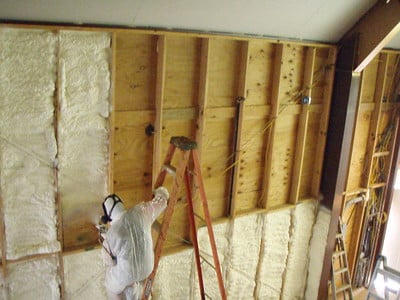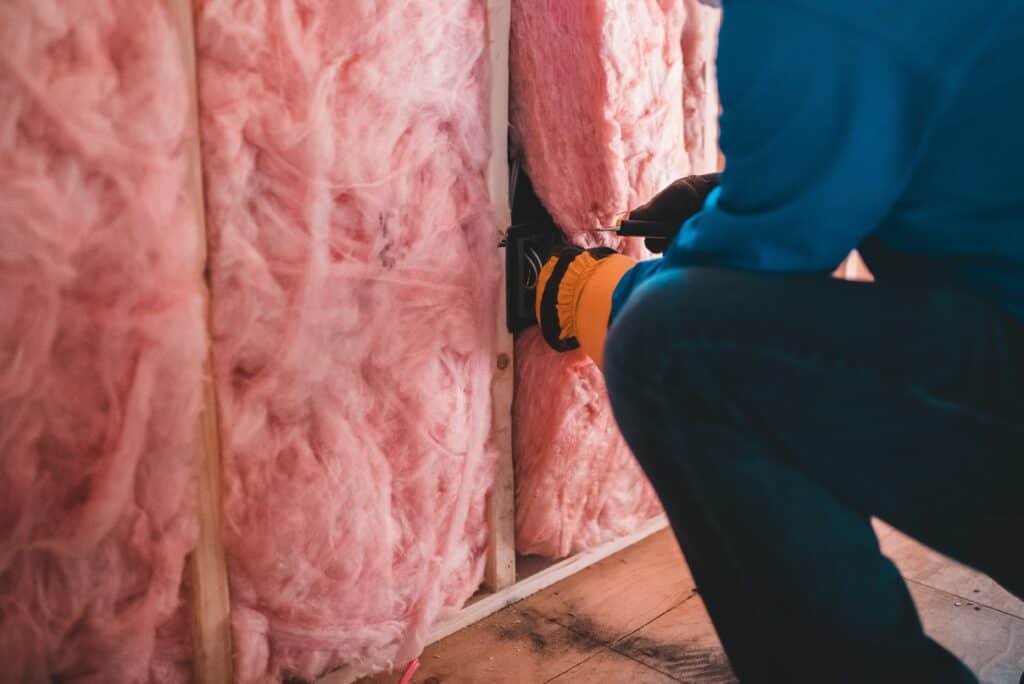Introduction – Home Insulation Guide
Home insulation is a material or combination of materials that is used to prevent the transfer of heat, sound, or cold between interior and exterior spaces. It is typically installed in walls, ceilings, and floors to reduce energy costs and provide a more comfortable living environment. Insulation can also improve the overall energy efficiency of a home by reducing the amount of energy needed to heat or cool it. The benefits of insulation include improved energy efficiency, soundproofing, and cost savings. Use this article as a beginner’s home insulation guide.

There Are Three Types Of Insulation
There are three main types of home insulation: blanket insulation, loose-fill insulation, and spray foam insulation.
Blanket insulation is the most common type and is typically made of fiberglass, rock wool, or cellulose. It is usually installed in walls, attics, and floors to provide a barrier against heat and cold.
Loose-fill insulation is made of small particles of fiberglass, rock wool, or cellulose and is typically used in areas that are hard to reach with blanket insulation.
Spray foam insulation is a type of plastic foam that is sprayed into walls and ceilings to create an airtight seal and provide insulation.
The R-Value Measures The “Power” Of The Insulation
The R-value is a quantitative measure of thermal resistance used predominantly in the building and construction industry. It is calculated as the ratio of the temperature difference across an insulator (ΔT, in degrees Celsius or Fahrenheit) and the heat flux, denoted as q (heat transfer per unit area, typically measured in watts per square meter). This means that the R-value is expressed in units such as square-meter degree Celsius per watt (m²·°C/W) or square-foot degree Fahrenheit per BTU (ft²·°F/BTU).
Mathematically, the formula for R-value is:
R-value = ΔT / q
This quantification helps to determine the insulating power of a material. Higher R-values indicate that a material is better at resisting the flow of heat, therefore, enhancing the insulating power. This makes R-values a key parameter for comparing the insulating effectiveness of different types of insulation materials.
While a higher R-value is generally associated with superior insulation, it doesn’t invalidate the potential utility of lower R-value materials. For instance, if a high R-value insulation material is derived from environmentally unfriendly sources, it may be prudent to consider a low R-value, eco-friendly alternative instead. Although a lower R-value means less insulating power per unit thickness, it doesn’t necessarily translate to poor insulation. You can still achieve the desired insulating effect with a low R-value material by increasing the thickness of the insulation layer.
However, it’s crucial to consider other factors such as the environmental impact, cost, space constraints, and other physical properties of the insulation material when making a choice. This comprehensive home insulation guide will provide further insights on how to select the most suitable insulation material for your specific needs.
Steps to Choose the Right Home Insulation
Climate – When choosing home insulation, it is important to consider the climate of where you live as well as the existing insulation in your home. Different types of insulation are better suited for different climates and it is important to choose a type that will best meet your needs.
Evaluate Existing Insulation – It is also important to consider the existing insulation in your home so that you can determine if an upgrade is necessary. It almost doesn’t matter what is your home heating or cooling system, all of them will benefit from better insulation.
Budget – Finally, it is important to consider your budget when selecting insulation to make sure that you get the best value for your money.
How to Install The Three Types Of Home Insulation
The installation process for home insulation depends on the type of insulation you choose. Blanket insulation is typically installed in walls, attics, and floors by cutting it to fit the targeted area and then stapling it in place. Loose-fill insulation requires a special machine to blow the insulation into the targeted area. Spray foam insulation is installed by spraying the foam into walls and ceilings using a specialized machine.
Blanket Insulation
Blanket insulation is typically installed in walls, attics, and floors by cutting it to fit the targeted area and then stapling it in place. It is the most common type of insulation and is available in batts and rolls. Batts are pre-cut sections of insulation that are designed to fit between standard framing studs and joists. Rolls are large rolls of insulation that must be cut to size. To install blanket insulation, you will need a measuring tape, utility knife, and a stapler.
1. Measure the space where the insulation will be installed.
2. Cut the insulation to fit the space, making sure to leave a ½-inch gap between the insulation and the walls.
3. Place the insulation in the space and use a stapler to secure it in place.
Loose-Fill Insulation
Loose-fill insulation is made of small pieces of fiberglass, cellulose, or mineral wool and is designed to fill small spaces and attics. This type of insulation is installed using a blowing machine.
1. Measure the space that needs to be insulated.
2. Fill the blowing machine with the appropriate type of insulation.
3. Connect the machine to an outlet and turn it on.
4. Point the machine in the direction of the space that needs to be insulated and start blowing.
5. Move the machine around the space, ensuring that the insulation is evenly distributed.
Spray Foam Insulation
This type of insulation is sprayed directly onto the surface to be insulated. It is available in two forms – open-cell and closed-cell – and is used to insulate walls, ceilings, and floors. To install spray foam insulation, you will need a spray foam gun and protective gear.
1. Put on protective gear, including a face mask, safety glasses, and gloves.
2. Attach the spray foam gun to an air compressor.
3. Fill the gun with the appropriate type of foam insulation.
4. Point the gun at the surface to be insulated and start spraying.
5. Move the gun in a steady, sweeping motion, ensuring that the insulation is evenly distributed.
Cost Comparison Of The Three Types Of Insulation
Blanket Insulation: This type of insulation is one of the most affordable options, with prices ranging from $0.25 to $1.50 per square foot. Installation costs will vary depending on the size of the space being insulated.
Loose-Fill Insulation: This type of insulation is typically more expensive than blanket insulation, with prices ranging from $0.80 to $2.00 per square foot. The installation cost will depend on the size of the space and the type of insulation being used.
Spray Foam Insulation: This type of insulation is more expensive than the other two options, with prices ranging from $2.50 to $6.00 per square foot. Installation costs will depend on the size of the space and the type of insulation being used.
Conclusion – Home Insulation Guide

In conclusion, home insulation is a great investment for any homeowner looking to reduce their energy costs and improve the comfort of their home. There are many different types of insulation available, ranging from blanket insulation to spray foam insulation. It is important to consider the climate, existing insulation, and budget when selecting the right type of insulation for your home. Additionally, the installation process varies depending on the type of insulation, so it is important to understand the steps involved before beginning the process. With the right insulation and installation, you can enjoy the many benefits of home insulation.
